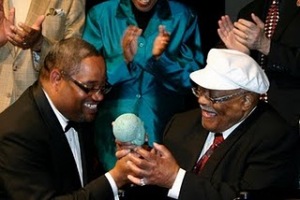By Joel Francis
The Daily Record
Saturday’s Branford Marsalis concert at the Gem Theater was a night of new beginnings.
The show kicked off the 2010-2011 season of Jammin’ at the Gem and featured new bass player Robert Hurst – this was only his second gig with the quartet in as many nights. It even opened with a new song.
 That number, tentatively titled “Joey’s Tune” after its composer, pianist Joey Calderazzo, was a bit of an outlier. Admittedly a work in progress, the arrangement was busy to the point of claustrophobia. When Marsalis stepped back, Calderazzo and drummer Justin Faulkner flooded the room so completely one wondered if Marsalis would be able to wedge his way back in the song.
That number, tentatively titled “Joey’s Tune” after its composer, pianist Joey Calderazzo, was a bit of an outlier. Admittedly a work in progress, the arrangement was busy to the point of claustrophobia. When Marsalis stepped back, Calderazzo and drummer Justin Faulkner flooded the room so completely one wondered if Marsalis would be able to wedge his way back in the song.
Fortunately, the rest of the two-hour set fared better. Alternating between soprano and tenor saxophones, Marsalis guided the band through breakneck changes and lumbering mood pieces. Some of his solos displayed the pop sensibilities that made him the go-to hornsmith for Sting and Bruce Hornsby, yet his playing was always challenging, never resting too lightly on the ears.
If the set had one blemish it was that Marsalis seemed too content to introduce a number with a solo, then step away for the rest of the number to let his trio play. Aside from being the best player onstage, Marsalis’ horn was the catalyst that helped the rest of the sounds to coalesce.
“The Blossom of Parting,” a track from Marsalis’ 2009 album “Metamorphosen” was the high point of night. The song opened softly with Marsalis on soprano sax, and Faulkner switching between brushes and mallets to build new textures. Calderazzo’s mesmerizing solo blurred the lines between jazz and classical music, and showed more than a hint of Brad Mehldau’s plaintive style. When the band re-entered, Marsalis gradually built the song’s intensity. Before the song could climax, however, an over-exuberant Faulkner accidentally knocked his ride cymbal to the floor. It wasn’t the ending Marsalis hoped for, but the audience took in stride and responded with a standing ovation.
Faulkner had no problem filling the drum stool occupied by Marsalis’ longtime beatman Jeff “Tain” Watts. On a cover of Thelonious Monk’s “Teo,” Faulkner traded bars with Marsalis with a maturity that outpaced his age of 19 and an energy that underlined it. His solo during a later song recalled another drummer of Marsalis’ acquaintance, Art Blakey.
Hurst also handled himself well, despite sight-reading all of the material. His lengthy solo would have worked better tied to a song than as a stand-alone piece. Aside from that moment, Hurst drew little attention to himself – a positive attribute for now in these new surroundings.
The evening ended with an encore of “St. Louis Blues” that found Marsalis showing off his New Orleans roots and reeling off some Satchmo-like trumpet licks on his saxophone.
Keep reading:















